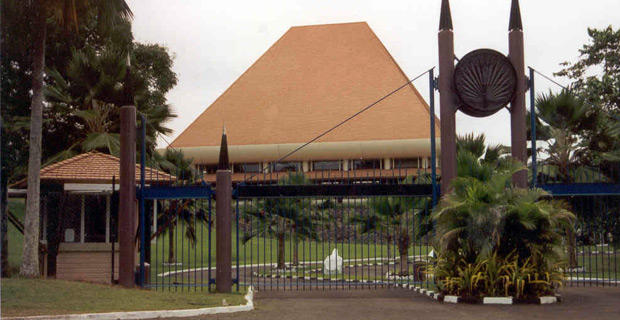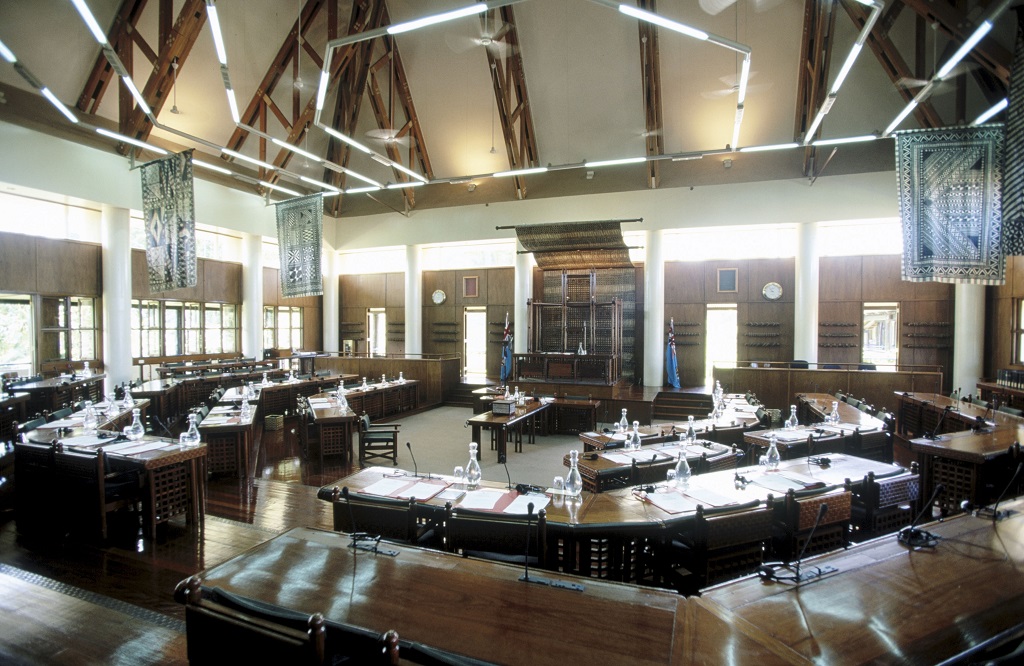Parliament of Fiji
The Parliament complex at Veiuto was opened in 1992 with a traditional Fijian house design that included masi cloths, wooden furnishings and open-air corridors. Parliament was suspended following the 2006 coup and the building has remained unoccupied ever since. Parliament now meets in the government buildings near Albert Park.
Last updated on 24 May 2025
Narrated by Tomasi Raiyala


Timeline
1871
The first European settlers attempted to set up a government system in Levuka. Ratu Cakobau was proclaimed the ‘Tui Viti’, and a first attempt to set up a parliament was made.
1874
This initial experiment failed and a Deed of Cession was signed making Fiji a British Crown colony. A Legislative Council was formed, headed by the British Governor. Levuka remained the administrative centre.
1882
A new government precinct was established at the southern end of the Suva peninsula. Some government buildings were dismantled and transported from Levuka.
1904
For the first time the Legislative Council included 2 iTaukei members who were nominated by the Great Council of Chiefs and appointed by the Governor.
1929
The Legislative Council was restructured to include three elected Indian seats.
1939
A new government building was constructed in an art deco style designed by architect Walter Frederick Hedges.
1963
For the first time, women were given the right to vote in Fiji. ITaukei were also allowed to vote for their own representatives on the Legislative Council, rather than be appointed by the Great Council of Chiefs.
1966
The first election with universal suffrage was held this year.
1967
A ministerial system was adopted whereby 3 members of the Legislative Council were elected to the Executive Council.
1970
Fiji became independent and the Legislative Council was renamed the House of Representatives. Ratu Sir Kamisese Mara, the leader of the Alliance party, was the first Prime Minister. His party would remain in power for 17 years. The first Parliament session was held in the government-building precinct on Victoria Parade.
1987
In April, a multi-ethnic coalition led by Timoci Bavadra won the national general election. On 14 May ten masked armed soldiers entered the House of Representatives and Lieutenant Colonel Sitiveni Rabuka succeeded in overthrowing the government. In October he declared Fiji a republic, abrogated the constitution and declared himself head of an interim military government.
1990
A new constitution was introduced.
1992
The first national general election since the military coups of 1987 was held in May. Rabuka became Prime Minister. In June a new Parliament complex was opened in Veiuto, built with indigenous Fijian designs.
1997
A new constitution was introduced after a constitutional review the previous year. It was written by a commission composed of Sir Paul Reeves, Governor-General of New Zealand, Tomasi Vakatora, an indigenous Fijian businessman and former politician, and Dr Brij Lal, an Indo-Fijian historian.
1999
Mahendra Chaudhry, leader of the Fiji Labour Party, became Fiji’s first elected Indo-Fijian Prime Minister in May.
2000
A group led by failed businessman George Speight entered parliament buildings on 19 May and held the Prime Minister and parliamentarians hostage for 56 days. Soon after the hostages were released, Speight was arrested and Parliament was restored.
2001
Laisenia Qarase, leader of the Soqosoqo Duavata ni Lewenivanua (United Fiji Party) was elected as Prime Minister.
2006
In May the Qarase government had a narrow victory in the national general elections. Naval officer Commodore Josaia Voreqe Bainimarama announced on 6 December that the military had taken control of the government, and later assumed office as Prime Minister.
2013
A new constitution was introduced in September. It replaced the Senate and House of Representatives with a 50-member Parliament chamber.
2014
The Fiji First Party won the national general election. The incumbent Prime Minister Frank Bainimarama was re-elected. Parliament returned to the Government Buildings in Victoria Parade.
References
Journal of the Legislative Council and of the House of Representative. (1970). Suva: Government Press.
Judy Tudor (1972) Handbook of Fiji, Sydney: Pacific Publication.
Elsie Stephenson (1997) Fiji’s Past on Picture Postcards, Suva: Caines Jannif.
Stephen Sherlock, (1997) “Constitutional and Political Change in Fiji”, Research Paper 7, Parliament of Australia.